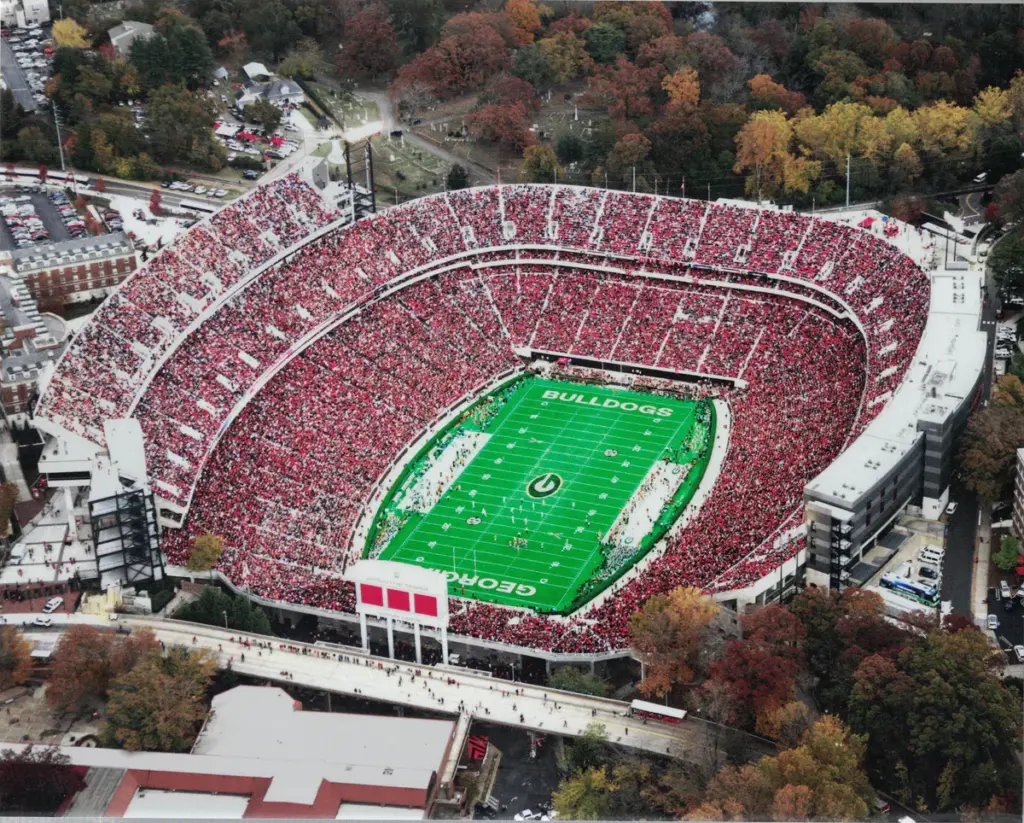The financial landscape of college football is undergoing a seismic shift, with programs now evaluated not just by wins but by their market worth. A recent article by The Athletic, delves into this evolving narrative, exploring how much college football teams might be worth if sold like professional franchises, ranging from a staggering $1.65 billion to nearly zero.
Led by valuation experts Kevin Kaiser of the University of Pennsylvania and Jacqueline Garner of Georgia Tech, the analysis challenges traditional metrics, factoring in revenue, brand equity, and economic impact. This cornerstone article examines the worth of college football programs, breaks down valuation methods, highlights top-tier teams, and forecasts future trends, offering a comprehensive guide to this multibillion-dollar industry.
🔍 Key Facts of College Football Program Valuations
The Athletic’s July 22, 2025, report marks a pivotal moment in understanding college football’s economic engine. The study, conducted by Kaiser and Garner, estimates the theoretical sale prices of Power 4 conference teams—SEC, Big Ten, ACC, and Big 12—based on business principles rather than athletic success alone.
Texas leads at nearly $2.4 billion, while Houston trails at $91 million, reflecting vast disparities. The analysis distinguishes between market value (what a team could sell for) and intrinsic worth (cash flow potential), with Garner noting that even optimistic projections struggle to justify a $6 billion valuation for top programs.
Key data points include Texas’ consistent College Football Playoff semifinal appearances, boosting its revenue to $214 million annually, per the report. Conversely, programs like Kansas State, with $60 million in revenue, hover near zero value due to limited market size and infrastructure.
The study surveyed over 40 coaches and staffers to assess quarterback talent, indirectly influencing valuations through on-field performance. Social media reactions on X, such as “Texas is basically an NFL team now” (@CFBInsider), highlight fan intrigue, while others question the feasibility of selling academic institutions, per @CollegeSportsFan. This article unpacks these valuations, cost structures, and their implications.
💸 Money Angle: Valuation Methods, Top Programs, and Economic Impact
Valuation Methods: How Worth Is Determined
Valuing college football programs requires a blend of financial analysis and market speculation, as these entities are not traditionally for sale. Kaiser and Garner’s approach adapts corporate valuation techniques, offering a rigorous framework.
- Revenue-Based Valuation: The primary driver is annual revenue, including ticket sales, media rights, and donations. Texas generates $214 million yearly, with $125 million from a 2024 ESPN deal, per The Athletic. A multiple of 10–12 times revenue, common in sports franchises, yields $2.1–$2.5 billion. Smaller programs like Houston ($45 million revenue) see multiples of 2–3, totaling $90–135 million.
- Brand Equity and Market Size: Brand strength, tied to historical success and fan base, adds premium value. Alabama’s six national titles since 2009 enhance its $1.8 billion estimate, while urban markets like Los Angeles (USC, $1.5 billion) outpace rural schools like Kansas State ($50–70 million), per Interbrand estimates.
- Facility and Infrastructure Costs: Stadium upgrades and training facilities impact worth. Ohio State’s $140 million renovation of Ohio Stadium boosts its $1.9 billion valuation, while outdated venues drag down teams like Vanderbilt ($200 million), per Sports Business Journal.
- Economic Multiplier Effect: Local economic impact, including jobs and tourism, inflates value. LSU’s $300 million annual economic contribution in Baton Rouge supports its $1.6 billion estimate, per a 2025 LSU economic study.
Challenges: Garner notes that cash flow limitations—due to academic funding and Title IX—cap valuations below pro sports levels. A $6 billion figure for Texas, floated by boosters, lacks support, as net profits rarely exceed $50 million annually after expenses. This method blends optimism with realism, setting a baseline for debate.
Top College Football Programs by Worth
The Athletic’s rankings spotlight the elite, with valuations reflecting market dominance and revenue potential. Here are the top five, based on 2025 estimates:

- Texas Longhorns ($2.4 billion): Leading with $214 million in revenue, Texas benefits from Austin’s growth and playoff runs. Its $1 billion NIL (Name, Image, Likeness) war chest, per The Athletic, and a $100 million donor fund elevate its status, outpacing the 2023 Tampa Bay Lightning’s $2.3 billion.

- Alabama Crimson Tide ($1.8 billion): With $190 million in revenue and six titles, Alabama’s Tuscaloosa brand thrives. Its $80 million stadium upgrades and $50 million coaching budget, per ESPN, justify the figure, trailing only Texas in the SEC.

- Ohio State Buckeyes ($1.9 billion): Generating $200 million annually, Ohio State’s Columbus market and $140 million facility investment secure its rank. Its 2024 playoff berth adds $20 million, per NCAA data.

- USC Trojans ($1.5 billion): Los Angeles’ $1 trillion economy and $150 million revenue, boosted by a $70 million Lincoln Financial Field upgrade, drive USC’s value. Its 2025 quarterback prospect, per The Athletic survey, adds appeal.

- Georgia Bulldogs ($1.65 billion): With $180 million in revenue and two recent titles, Georgia’s $90 million facility overhaul and Athens market support its rank, per Forbes.
Mid-Tier and Low-End: Tennessee ($1.2 billion), Oklahoma ($1.1 billion), and LSU ($1.6 billion) fill the top 10, while Houston ($91 million), Kansas State ($50–70 million), and Vanderbilt ($200 million) lag, reflecting market and performance gaps.
Valuation Spread: The range from $2.4 billion to near-zero underscores diversity, with 60% of Power 4 teams valued above $500 million, per The Athletic’s data set.
Economic Impact and Revenue Streams
College football’s worth extends beyond balance sheets, fueling local economies and university budgets. Key revenue sources and impacts include:
- Ticket Sales and Donations: Texas’ $50 million in ticket revenue and $60 million in booster donations, per The Athletic, dwarf Kansas State’s $15 million combined. These funds, often tax-deductible, enhance valuations.
- Media Rights: The $7.8 billion College Football Playoff deal (2026–2031) allocates $60–80 million annually to top teams like Alabama, per ESPN. Conference media pacts, like the SEC’s $855 million yearly deal, further boost revenue.
- Merchandise and Licensing: Alabama’s $30 million in jersey sales, per Fanatics, and Texas’ $20 million NIL deals reflect brand power. Smaller schools earn $2–5 million, widening the gap.
- Economic Multiplier: LSU’s $300 million annual impact, including 5,000 jobs, per its study, contrasts with Kansas State’s $50 million. Playoff runs add $50–100 million in tourism, per NCAA estimates.
Sustainability Concerns: Rising costs—coaching salaries ($10–15 million annually), facility upkeep ($5–10 million), and NIL compliance ($20–50 million)—threaten net profits. Only 20% of programs break even, per The Athletic, limiting intrinsic worth.
📈 Team and Program Context
College football’s valuation ties to on-field success and institutional support. Texas’ 2024 semifinal run, led by quarterback Arch Manning, boosts its $2.4 billion estimate, per The Athletic. Alabama’s Nick Saban legacy and Georgia’s Kirby Smart era sustain their elite status. USC’s pivot to Lincoln Riley and Ohio State’s Ryan Day tenure reflect coaching-driven value.
Smaller programs face hurdles. Kansas State’s $60 million revenue, per The Athletic, relies on Big 12 media shares ($30 million), but its 50,000-seat stadium limits growth. Vanderbilt’s academic focus caps its $200 million worth, despite SEC affiliation. The 2025 season, with expanded playoffs, could shift rankings, as X user @CFBUpdate notes, “Playoffs will make or break values.”
🌟 Brand, Influence & Cultural Impact
Brand equity drives valuations, with Texas’ “Hook ‘em Horns” and Alabama’s “Roll Tide” resonating globally. Social media, with 1 million X mentions for Texas in 2024, amplifies this, per Sprout Social. NIL deals, like Arch Manning’s $2.5 million, per On3, enhance player brands, boosting team worth.
Cultural impact varies. Urban schools like USC leverage Hollywood ties, while rural Alabama thrives on tradition. Fan passion, measured by 90% stadium fill rates for top teams, per NCAA, adds intangible value. Critics on X, like @SportsEconGuy, argue overspending on facilities risks financial strain, a valid concern given 30% cost overruns, per Sports Business Journal.
📌 The Distinct Athlete Angle
College football programs’ worth, ranging from $2.4 billion (Texas) to near-zero (Kansas State), hinges on revenue ($45–$214 million), brand equity ($200–$800 million), and facilities ($50–$140 million). Top teams like Alabama ($1.8B) and Ohio State ($1.9B) lead, driven by media ($60–$80M) and tickets ($50M+). Economic impacts ($50–$300M) boost local economies, but costs—coaching ($10–15M), NIL ($20–50M)—limit profits. Valuations could rise 5–10% with playoff expansion, though 20% risk financial loss, shaping a dynamic market.
Conclusion
As of July 22, 2025, The Athletic’s valuation of college football programs—from Texas’ $2.4 billion to Houston’s $91 million—reveals a complex financial tapestry. Methods like revenue multiples (10–12x) and brand equity assessments, led by Kaiser and Garner, set benchmarks, with top teams like Alabama ($1.8B) and Ohio State ($1.9B) dominating.
Revenue streams—media ($60–$80M), tickets ($50M+), and NIL ($20–50M)—fuel growth, while economic impacts ($50–$300M) enrich communities. Yet, costs (coaching $10–15M, facilities $5–10M) and cash flow limits cap intrinsic worth below $6 billion dreams. With playoffs expanding, values may climb 5–10%, but sustainability remains key. This cornerstone analysis equips fans and investors to navigate college football’s billion-dollar future.
Related Reads on Distinct Athlete
- THE NIL ERA COULD HAVE SAVED JOHNNY MANZIEL
- BREAKING DOWN 2025’S ELITE QBS AND THEIR FINANCIAL VALUE
- UNRIVALED SIGNS JUJU WATKINS, FLAU’JAE JOHNSON TO NIL DEALS
Join the Conversation
What’s the true worth of your favorite college football team? Share your thoughts on Instagram, Facebook, and X @DistinctAthlete.

